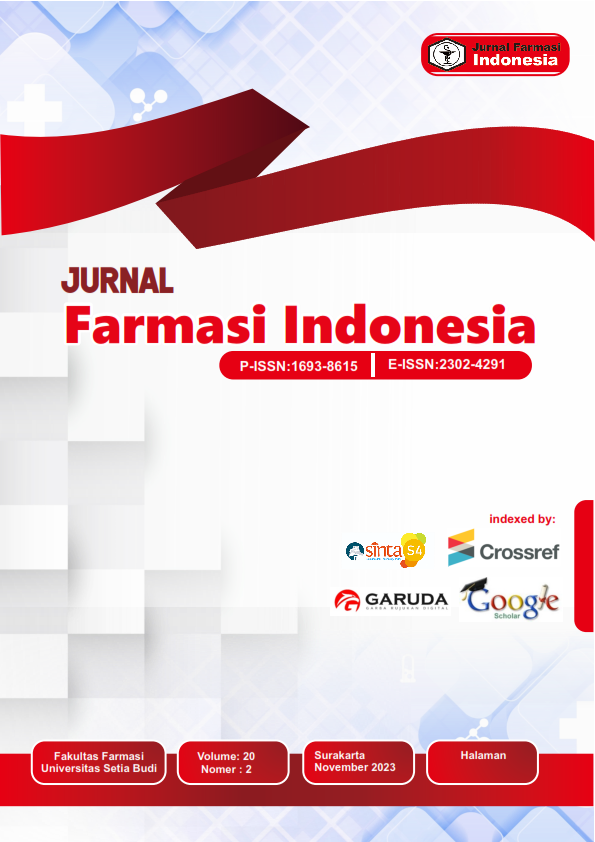Innovation in Fermentation: Enhancing Antioxidant Content in Rice Bran Using Aspergillus Oryzae
Abstract
This study aims to assess the antioxidant activity of fermented rice bran extract as an innovative approach to enhance the content of bioactive compounds. Although rice bran is known for its richness in phenolic compounds and γ-oryzanol, the use of enzymatic fermentation to increase its bioactivity remains limited. The research explores the antioxidant activity of fermented rice bran extract, providing fresh insights into harnessing the untapped potential of natural antioxidants. Rice bran was fermented with Aspergillus oryzae for 7, 14, and 21 days. The fermented product was then extracted using 70% ethanol, and its antioxidant activity was determined in vitro using the DPPH method. The results indicated that a 14-day fermentation exhibited the highest antioxidant activity (AAI 1.47), categorized as strong antioxidant activity. For non-fermented rice bran and 7-day fermentation, AAI values were 1.09 and 1.05, respectively. Fermentation for 21 days showed the lowest antioxidant activity (AAI 0.55), which was categorized as moderate. These findings contribute to understanding the impact of fermentation duration on the antioxidant activity of rice bran, supporting its potential as a valuable source of antioxidants.
References
[2] Y. Kurniati, S. Budijanto, L. Nuraida, F. Nur, and A. Dewi, “Peningkatan Senyawa Fenolik Bekatul dengan SSF (Solid State Fermentation) sebagai Pencegah Kanker Enhancement of Phenolic Compounds of Rice Bran with SSF (Solid State Fermentation) for Preventing Cancer,” Iptek Tanam. Pangan, vol. 12, no. 2, pp. 97–104, 2017, [Online]. Available: http://ejurnal.litbang.pertanian.go.id/index.php/ippan/article/view/8175
[3] W. N. Suhery, A. Fernando, and N. Has, “Uji Aktivitas Antioksidan dari Ekstrak Bekatul Padi Ketan Merah dan Hitam (Oryza sativa L. var. glutinosa) dan Formulasinya Dalam Sediaan Krim,” Pharmacy, vol. 13, no. 101–115, pp. 494–504, 2016.
[4] A. Purwanto, A. N. Fajriyati, and D. Wahyuningtyas, “Pengaruh Jenis Pelarut Terhadap Rendemen dan Aktivitas Antioksidan dalam Ekstrak Minyak Bekatul Padi,” Ekuilibrium, vol. 13, no. 1, pp. 29–34, 2014.
[5] I. W. Rai Widarta and I. W. Arnata, “Stabilitas Aktivitas Antioksidan Ekstrak Bekatul Beras Merah Terhadap Oksidator dan Pemanasan pada Berbagai pH,” J. Teknol. dan Ind. Pangan, vol. 25, no. 2, pp. 193–199, 2014, doi: 10.6066/jtip.2014.25.2.193.
[6] N. Rahmi, N. Khairiah, Rufida, S. Hidayati, and A. Muis, “Pengaruh fermentasi terhadap total fenolik, aktivitas penghambatan radikal dan aktivitas antibakteri ekstrak tepung biji teratai ( Nymphaea pubescens Willd .),” Jbi, vol. 11, no. 1, pp. 9–18, 2020.
[7] G. P. Adi Wira Kusuma, K. Ayu Nocianitri, and I. D. P. Kartika Pratiwi, “Pengaruh Lama Fermentasi Terhadap Karakteristik Fermented Rice Drink Sebagai Minuman Probiotik Dengan Isolat Lactobacillus sp. F213,” J. Ilmu dan Teknol. Pangan, vol. 9, no. 2, p. 181, 2020, doi: 10.24843/itepa.2020.v09.i02.p08.
[8] N. Suhartatik*, M. Nur Cahyanto, S. Raharjo, and E. S. Rahayu, “Antioxidant Activity of Anthocyanin of Black Glutinous Rice During Fermentation,” J. Teknol. dan Ind. Pangan, vol. 24, no. 1, pp. 115–119, 2013, doi: 10.6066/jtip.2013.24.1.115.
[9] H. J. B. Kunnaryo and P. R. Wikandari, “Antosianin dalam Produksi Fermentasi dan Perannya sebagai Antioksidan,” Unesa J. Chem., vol. 10, no. 1, pp. 24–36, 2021, doi: 10.26740/ujc.v10n1.p24-36.
[10] S. Kapnoor and V. H. Mulimani, “Production of α-galactosidase by aspergillus oryzae through solid-state fermentation and its application in soymilk galactooligosaccharide hydrolysis,” Brazilian Arch. Biol. Technol., vol. 53, no. 1, pp. 211–218, 2010, doi: 10.1590/S1516-89132010000100026.
[11] P. Barbesgaard, H. P. Heldt-Hansen, and B. Diderichsen, “On the safety of Aspergillus oryzae: a review,” Appl. Microbiol. Biotechnol., vol. 36, no. 5, pp. 569–572, 1992, doi: 10.1007/BF00183230.
[12] N. Suningsih, W. Ibrahim, O. Liandris, and R. Yulianti, “Kualitas Fisik dan Nutrisi Jerami Padi Fermentasi pada Berbagai Penambahan Starter,” J. Sain Peternak. Indones., vol. 14, no. 2, pp. 191–200, 2019, doi: 10.31186/jspi.id.14.2.191-200.
[13] H. Y. Shin, S. M. Kim, J. H. Lee, and S. T. Lim, “Solid-state fermentation of black rice bran with Aspergillus awamori and Aspergillus oryzae: Effects on phenolic acid composition and antioxidant activity of bran extracts,” Food Chem., vol. 272, pp. 235–241, 2019, doi: 10.1016/j.foodchem.2018.07.174.
[14] F. Kong et al., “Aspergillus oryzae and aspergillus niger co-cultivation extract affects in vitro degradation, fermentation characteristics, and bacterial composition in a diet-specific manner,” Animals, vol. 11, no. 5, 2021, doi: 10.3390/ani11051248.
[15] Y. Wu et al., “In vitro gastrointestinal digestion and fecal fermentation reveal the effect of different encapsulation materials on the release, degradation and modulation of gut microbiota of blueberry anthocyanin extract,” Food Res. Int., vol. 132, no. November 2019, p. 109098, 2020, doi: 10.1016/j.foodres.2020.109098.
[16] Y. S. Yi, “New mechanisms of ginseng saponin-mediated anti-inflammatory action via targeting canonical inflammasome signaling pathways,” J. Ethnopharmacol., vol. 278, no. June, p. 114292, 2021, doi: 10.1016/j.jep.2021.114292.
[17] S. Hartati, Y. Marsono, and U. Santoso, “Komposisi Kimia Serta Aktivitas Antioksidan Ekstrak Hidrofilik Bekatul Beberapa Varietas Padi,” J. Agritech, vol. 35, no. 1, pp. 35–42, 2015.
[18] R. F. Anggraini and S. B. Widjanarko, “Pengaruh Penambahan Ekstrak Bekatul Terhadap Aktivitas Antioksidan, Total Fenol, Dan Kadar Flavonoid Minuman Fungsional Sari Jagung-Ekstrak Bekatul,” J. Pangan dan Agroindustri, vol. 6, no. 1, pp. 53–63, 2018, doi: 10.21776/ub.jpa.2018.006.01.7.
[19] I. W. . Widarta, K. A. Nocianitri, and L. P. I. P. Sari, “Ekstraksi Komponen Bioaktif Bekatul Beras Lokal Dengan Beberapa Jenis Pelarut,” J. Apl. Tekologi Pangan, vol. 2, no. 2, pp. 75–79, 2013.
[20] S. H. Huang and L. T. Ng, “Quantification of polyphenolic content and bioactive constituents of some commercial rice varieties in Taiwan,” J. Food Compos. Anal., vol. 26, no. 1–2, pp. 122–127, 2012, doi: 10.1016/j.jfca.2012.03.009.













